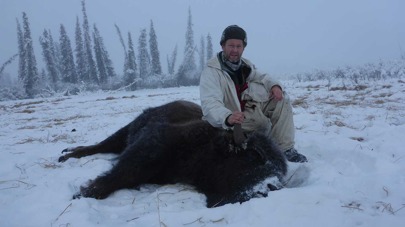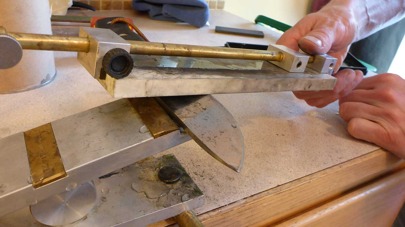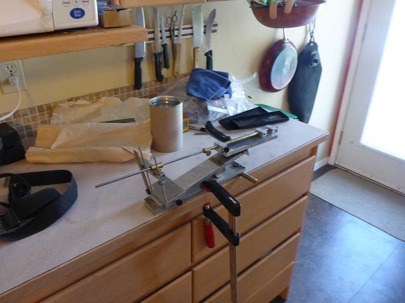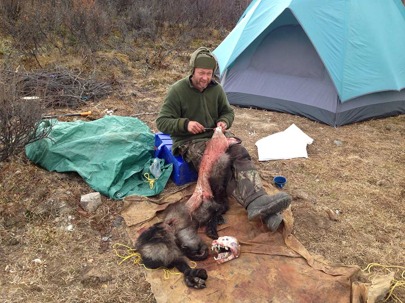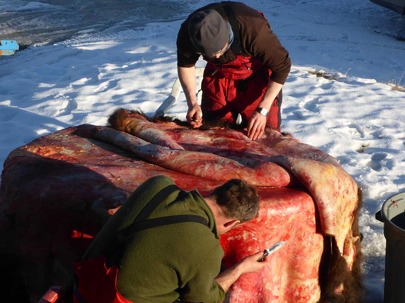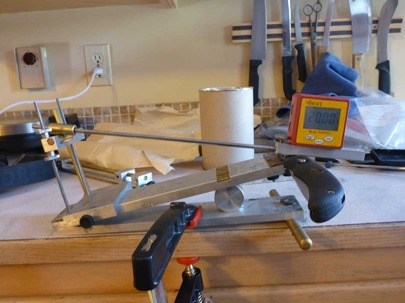User Experience using
EdgePal sharpening system.
Background:
My name is Gjermund Røsholt and I am from Passebekk in Norway but now lives in Yukon in Canada where I work as a professionally looking Guide MacMillan River Adventures in Yukon Territory, Canada. I guide clients from around the world two months a year hunting for moose, mountain sheep, caribou, grizzly bear, black bear, wolverine and wolf. Besides that, I have my own company Wild Tracks where I do guiding for fishing, hunting and trapping as well as forestry and mapping services. Besides this I do hunting, trapping and fishing all year round.
Chef
With so much butchering and skinning, you need sharp knives at all times. Over the years, I tested many different grinding tools, but all had their weaknesses, until I got in touch with Thomas Löfvenmark and bought me my first Chef. This has meant that I can easily keep my knives and gutting knifes sharp at all times and I can maintain the optimum angle that I want on my knives either I have straight angles or Convex angles.
It is also easy to grind gutting knifes like Eka and others. I use a convex diamond stone from Edgepal to sharpen my gutting knives. It works very well. As a guide, I use 3-4 knives and a two axes. Many guides use different American grinding jigs, but it is not difficult to see that the blades do not have an equal angle on both sides nor in blade length. With much hand grinding in the field are the edge get more and more curved and the function degrade over time. If you have a convex knife from Fällkniven, like FHK and F1 it is difficult to maintain a concise convexity of the knife in the field, therefore I prefer right angles on hunting knifes when you use mostly hand grinding. I use Chef in the main camp and hand grind with a ceramic whetstone and leather belt with abrasive paste (often use my own belt) in the field. Can also use EdgePal Forest, which is a wonderful tool in the field, light weight, compact size and give great results.
Home before season or between hunting periods, I sharpen only with Chef and ceramic hones; I do not use diamond stones as they often are too rough and make microscopic scratches on edge. Important to distinguish between grinding and honing edges, but both can be done with Chef, also if you want to set a completely new angle, this is easy with Chef.
I often use an ultra-fine ceramic whetstone since we often are talking about polishing of edges. However, eggs wears over time and a new grind-edge must be set followed by a new honing edge. I often aim for a 95% sharpness, not 100, as this means that the edge is faster blunt and need sharpening more often. The Fällkniven hone supplied is very good, use this a lot, and some other fine ceramic hones as well.
After honing and use of leather strap from Thomas I use a hard felt disk with sharpening compound for final polishing, essential to not grind the actual edge, just extremely close so the angle don’t changes. I also use an electronic angle tool although this is not required in Chef if you use it right. If the knife is dull and chips or I have to change the angle on knives with extremely hard steel, I use a belt sander and a round grinding stone with large diameter on splitting axes and forest axes. Could have done this on Chef with a coarser stone, but save some time on a belt sander or stone.
It is important to find the angle that is appropriate for the intended use of the knife in relation to steel laboratory performance (hardness and toughness) on the blade. During skinning my favorite knife a custom-made knife from Fredrik Håkonsen, the knife is in Vanadis 4E steel and not stainless. This knife has amazing features.. I use a straight angle with a total angle of 35-40 degrees to avoid chipping.
The great thing with Chef is that you can tweak the angle and keep it concise constantly, and you can adjust convexity and grinding all convex blades. Chef is unlike most other tools made of sturdy material and is very precise, a tool you can trust
I can without problems cape, gut and debone two moose ready for a shoulder mount before I need to sharpen the knife. I use the gutting knife a lot since this ensures shallow incision and you always undercutting to avoid skin damage.
So no matter what you do you probably have some knives, axes, etc. I recommend a Chef as base tool!
AxePal
I always bring AxePal on longer hunting trips, a wonderful tool that is lightweight, compact and gives fantastic results. Most people look at a ax as a rough tool that often are not as sharp, but when you guide in the timber with a horse, boat or on foot, you use the axe every day. Then you need to have a sharp ax with the right curve the job you want to do, this makes things go easily and efficiently. I really recommend AxePal.
IcePal
I remember very well the long stay on the edge of the tundra where one should live in the wilderness of fish and game during the trapping season through a biting cold winter with -35C as the warmest days. Ice fishing was important during those periods when the caribou didn’t show up. The Ice auger was tried out, but soon I could see gravel coming up of the hole, I had hit the shallow spot. No extra blade so grinding was the only solution, all angles and possibilities where tested, but nothing worked great, so it ends up with an ax and a chisel to get some food for supper.
If I only knew about IcePal there had been no issues, with IcePal it’s easy to hold a sharp edge at all times. IcePal is a "must have" tool for an ice fishing.
Conclusion
EdgaPal sharpening system is the best for the serious hunter angler or chef, the most reliable and precise system on the market today in my experience. A tool you have for years.
EdgePal also has a wonderful service and can help you get custom-made tools you may need with your EdgPal system.
I highly recommended it!
